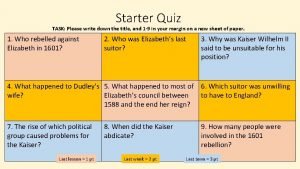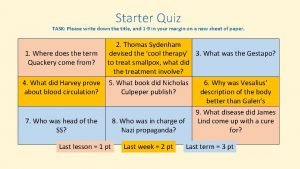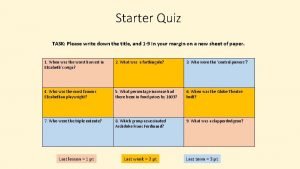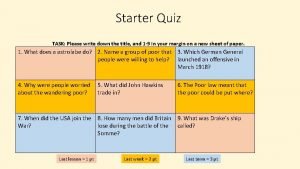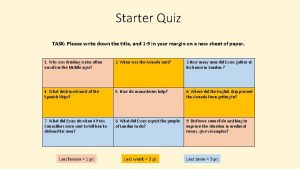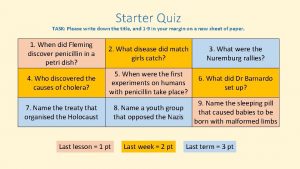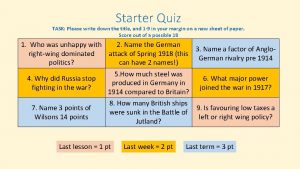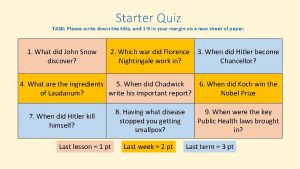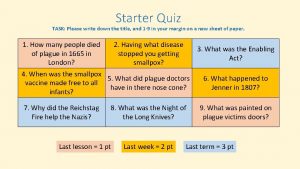Starter Quiz TASK Please write down the title












- Slides: 12

Starter Quiz TASK: Please write down the title, and 1 -9 in your margin on a new sheet of paper. 1. Religious group that disliked theatre? 2. Where would you wear a ruff? 3. What type of boat caused the Naval Race? 4. What was the heavy white make 5. Give a reason forb the rise of the 6. What entertainment did the -up made of? gentry? poor enjoy? 7. When was the Second Moroccan 8. When was the Entente Cordial crisis? signed? Last lesson = 1 pt Last week = 2 pt 9. Where were the cheapest tickets in theatre? Last term = 3 pt

Last lesson = 1 pt Last week = 2 pt Last term = 3 pt 1. Puritans 2. Around your neck 3. Dreadnought 4. lead 5. Tudors’ suspicion of the old Nobility or dissolution of the monasteries or increased wealth 6. Bear baiting, cock-fighting, gambling, drinking, football, wrestling 7. 1911 8. 1904 9. The pit or yard 1. Give yourself a score out of 18 2. In a green pen, you are going to write down which topic you need to develop you understanding of (Gentry/ theatre ; Society/ Fashion; Causes of WW 1) 3. For next lesson you need to create revision material on that topic. In that next lesson, you will be given a new quiz just on the topic you are revising.

Elizabeth Lesson 9: The Poor- reasons for the increase in poverty and attitudes and responses to poverty Even better: Good learning: Great learning: Understand why there was poverty in Elizabethan England Explain the attitudes to the poor in Elizabethan England Key Words: Enclosure, rackrenting, inflation, vagabonds Evaluate the effectiveness of Elizabeth and her Government in helping the poor

The poor The working poor made up about 50% of all families in Tudor England They were illiterate Did not own land Spent 80% of their income on food and drink Despite working hard their lives were very hard and they struggled to survive in difficult times. • Those who could not find work ended up begging as there was no unemployment benefit and the poor were very unlikely to have any savings. • Look at the sources on page 45: Why do you think there was seen to be a Poverty Crisis? • • •

The causes of poverty • Use the text, figures and sources on pages 46, 47 and 48 to create a diagram/ explanation of why there was poverty in England. • Make sure you include: • Rising population • Inflation and its causes • Trade problems with Antwerp (where 70% of English exports went to) • Monopolies • Bad/terrible harvests • Enclosure • Rack-renting (overly high rents) • The loss of monasteries

The causes of poverty • Using figures 5 a, 5 b and 6 when to you think poverty would have been at its worst in Elizabethan England? Explain your answer.

Attitudes to the poor 1. The deserving or ‘impotent poor’ 2. The undeserving or ‘idle poor’ • Explain the differing attitudes towards the 2 groups above • Create a table detailing the different types of beggars you could expect to see (p 48 -9) • How were these groups viewed by the rest of society? • Why would these groups cause problems for the ‘deserving poor’? • Why were groups of traveling or ‘wandering’ poor such a problem? • What do sources 10, 11 and 12 tell you about attitudes to the poor?

Evaluate the effectiveness of Elizabeth and her Government in helping the poor • Government policies: • Full recoinage, which had been planned by Queen Mary-helped slow inflation • Statute of Artifices (1563)- wage limits on skilled workers (attempt top slow inflation) • Act of Husbandry and tillage (1598)- slowed trend for enclosure • Using the information from earlier in the lesson and Figures on page 46/47 how well do you think the above worked?

Local Measures • Initially measures to help the poor took place at a local level as attempts were made to both help and control the poor. • Define the key terms: Alms, Censuses and Workhouse • In London the following hospitals were set up: • St Batholomew’s for the sick • St Thomas’ for the Elderly • Christ’s Hospital for orphans • Bethlehem Hospital (Bedlam) for the insane • What does this tell us about attitudes to the poor?

The Elizabethan Poor Law

Elizabethan Poor Law • Using the previous slide and pages 51 and 52 1. How effective was Elizabeth’s actions towards the poor? : a) For keeping social order b) Looking after the poor 1. Which group(s) were treated badly? 2. What do you think Elizabeth’s motivation was?

Elizabeth Lesson 9: The Poor- reasons for the increase in poverty and attitudes and responses to poverty Even better: Good learning: Great learning: Understand why there was poverty in Elizabethan England Explain the attitudes to the poor in Elizabethan England Key Words: Evaluate the effectiveness of Elizabeth and her Government in helping the poor
 Please write down your name
Please write down your name Starter task
Starter task Nobody said anything raymond carver
Nobody said anything raymond carver Tiered task bias task
Tiered task bias task Please come in and sit
Please come in and sit Please sit down and your seat belts
Please sit down and your seat belts Would you mind turning the music down
Would you mind turning the music down Our beloved father
Our beloved father Please jot down
Please jot down Seat and sit
Seat and sit Please sit down
Please sit down Application for the post of a waitress
Application for the post of a waitress Completing reports and proposals
Completing reports and proposals













